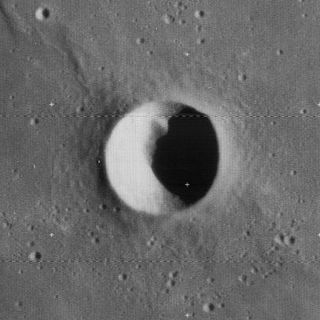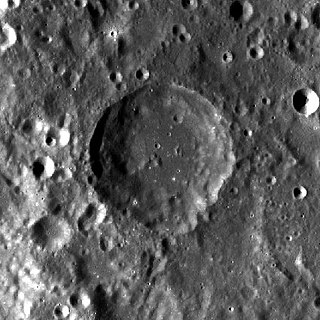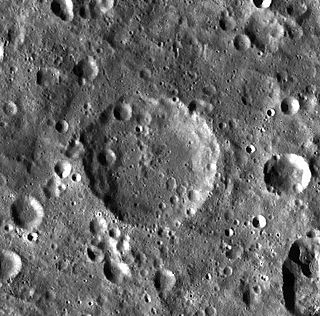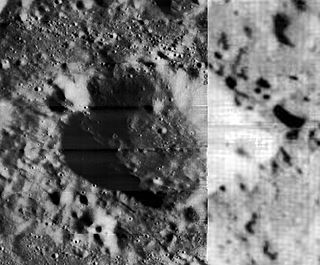
Armstrong is a small lunar impact crater located in the southern part of the Mare Tranquillitatis. It lies about 50 kilometers to the northeast of the Apollo 11 landing site, Tranquility Base. Named after American astronaut Neil Armstrong, the crater is the easternmost of the row of three craters named in honor of the Apollo 11 crew members. To the north is the Ranger 8 impact site.

Ching-Te is a small lunar impact crater located in a mountainous area to the east of the Mare Serenitatis. It is a circular, bowl-shaped formation with no distinguishing features.

Born is a small lunar impact crater located near the eastern edge of the Moon, to the northeast of the prominent crater Langrenus. It was previously designated Maclaurin Y before being named by the IAU in 1979. Maclaurin itself lies to the north.

Nielsen is a lunar impact crater on the Oceanus Procellarum. It is located north-east of Montes Agricola on the western hemisphere of the Moon. To the east-southeast is the crater Wollaston.

Arrhenius is a lunar impact crater that is located just on the far side of the Moon, near the southwest limb. In this location the vicinity of the crater can be viewed during favorable librations, although it is viewed from on edge. To the south-southeast is the worn crater Blanchard, and De Roy lies further to the west.

Borman is a lunar impact crater that is located in the southern hemisphere on the far side of the Moon. It lies across the southeast section of the mountainous inner ring, within the walled basin named Apollo.

Fechner is a lunar impact crater that lies on the far side of the Moon's southern hemisphere, attached to the western rim of the large walled plain Planck. The eastern rim of Fechner intersects the Vallis Planck, a long, wide cleft in the surface that follows a course to the north-northwest. This valley intrudes into the southeastern rim of the crater, then continues northwards from the periphery of the northeast rim.

Becquerel is a lunar impact crater that lies in the northern hemisphere on the far side of the Moon. This is an ancient and heavily worn formation that is now little more than an irregular buri in the surface. The outer rim has been worn and reshaped until it forms a rugged, mountainous region around the flatter interior.

Bečvář is a lunar impact crater that is located near the equator on the far side of the Moon. It lies to the northeast of the crater Necho, within that feature's ray system. To the north-northeast is the crater Gregory.

Chrétien is a lunar impact crater that is located in the southern hemisphere on the far side of the Moon from the Earth. It lies due south of the Mare Ingenii, one of the few maria on the Moon's far side. The crater lies in the midpoint between the craters Garavito to the west-southwest and Oresme to the east-northeast, both of these being somewhat smaller than Chrétien.

Davisson is a lunar impact crater that is located on the far side of the Moon from the Earth. This crater lies across the eastern rim of the huge walled plain Leibnitz, and the rim and outer rampart intrudes into the interior floor of Leibnitz. To the east-northeast of Davisson is the walled plain Oppenheimer, a formation only somewhat smaller than Leibnitz.

Chappe is a lunar impact crater that lies along the southwestern limb of the Moon. It is nearly attached to the northern limb of the walled plain Hausen, and an equal distance from the crater Pilâtre. To the north-northwest is Blanchard.

Danjon is a lunar impact crater on the far side of the Moon. It lies less than a crater diameter to the east-southeast of the larger crater Langemak. To the east-northeast of Danjon is the crater Perepelkin, and due south lies the walled plain Fermi.

Delporte is a lunar impact crater on the far side of the Moon. It overlies part of the northwestern rim of the huge walled plain Fermi, and the crater Litke is nearly attached to the southeastern rim.

Dellinger is a lunar impact crater that is located on the Moon's far side. It is attached to the southern rim of the crater Pannekoek. To the southeast lies the crater Marconi, and to the southwest is Chauvenet.

Dewar is a lunar impact crater that lies on the Moon's far side. Less than one crater diameter to the south-southwest is the crater Stratton. Vening Meinesz is a little over one crater diameter to the northwest. The slightly worn rim of this crater is roughly circular, with a small outward protrusion along the southern edge. The interior floor is marked by several small impacts along the eastern side.

Freundlich is a lunar impact crater that is located on the far side of the Moon. It lies midway between the craters Trumpler to the north-northwest and the irregular Buys-Ballot to the south-southeast. This crater has a circular rim that is more heavily eroded at the northern and southern ends. Groups of craters lie across the floor to the southeast and the north, and individual small craters lie elsewhere within the interior. The crater was named after Erwin Freundlich by the IAU in 1970.

Garavito is a lunar impact crater that is located in the southern hemisphere on the Moon's far side. It lies to the north-northwest of the huge walled plain Poincaré, and to the west of the crater Chrétien. It takes its name in honor of the Colombian astronomer and engineer Julio Garavito Armero.

Šafařík is a small lunar impact crater on the far side of the Moon. It lies due north of the crater Tiselius and to the east-southeast of Sharonov. This is a worn and eroded crater with smaller impacts along the rim to the east and northwest. The remainder of the worn rim and the interior are relatively featureless.

Ten Bruggencate is a lunar impact crater that lies on the far side of the Moon from the Earth, just to the east of the younger crater Lane. To the southeast of Ten Bruggencate is Chauvenet.






















